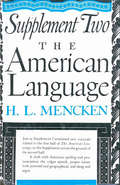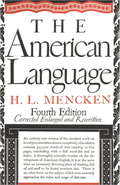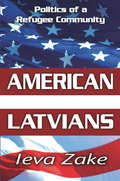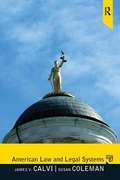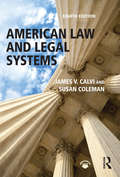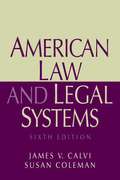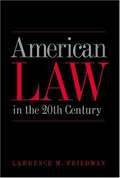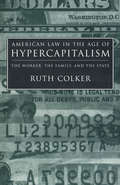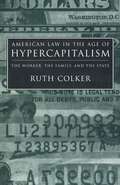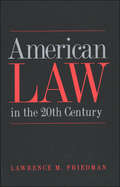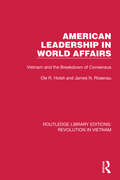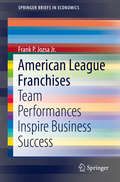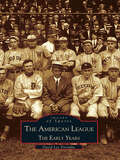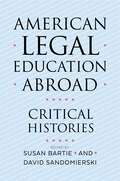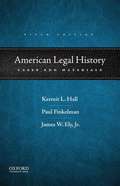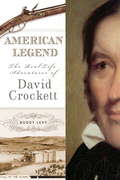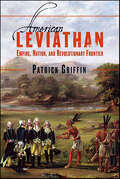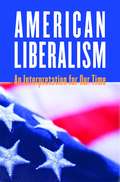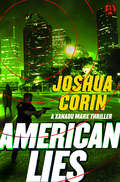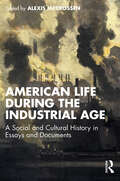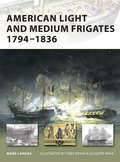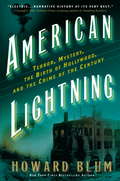- Table View
- List View
American Language Supplement 2
by H. L. MenckenThe DEFINITIVE EDITION OF The American Language was published in 1936. Since then it has been recognized as a classic. It is that rarest of literary accomplishments--a book that is authoritative and scientific and is at the same time very diverting reading. But after 1936 HLM continued to gather new materials diligently. In 1945 those which related to the first six chapters of The American Language were published as Supplement I; the present volume contains those new materials which relate to the other chapters.The ground thus covered in Supplement II is as follows:1. American Pronunciation. Its history. Its divergence from English usage. The regional and racial dialects.2. American Spelling. The influence of Noah Webster upon it. Its characters today. The simplified spelling movement. The treatment of loan words. Punctuation, capitalization, and abbreviation.3. The Common Speech. Outlines of its grammar. Its verbs, pronouns, nouns, adjectives, and adverbs. The double negative. Other peculiarities.4. Proper Names in America. Surnames. Given-names. Place-names. Other names.5. American Slang. Its origin and history. The argot of various racial and occupational groups.Although the text of Supplement II is related to that of The American Language, it is an independent work that may be read profitably by persons who do not know either The American Language or Supplement I.
American Language: An Inquiry into the Development of English in the United States (Fourth Edition)
by H. L. MenckenThis groundbreaking study clarifies the differences between British and American English and defines the distinguishing characteristics of American English. Cigar-chomping newspaperman H. L. Mencken succeeds not only in providing a lucid description of the American language but also in making his readers laugh, wince, and nod in agreement. It's a readable and fascinating study on why you say "tomayto" and I say "tomahto. " A must read for anyone who loves words. <P><P>[This text is listed as an example that meets Common Core Standards in English language arts in grades 11-12 at http://www.corestandards.org.]
American Latvians: Politics of a Refugee Community
by Ieva ZakeThis book analyzes the political experience of a small and unique American ethnic group-American Latvians. This community was constituted by post-World War II political refugees, who fled Communism and arrived in the United States seeking safety and protection. For decades, they insisted on preserving their ethnic identity and therefore did not call themselves Latvian Americans. Instead, they formed a distinctive double identity, that is, they blended into the American society economically and socially, but refused to become assimilated culturally and politically. The book offers a detailed look into the life of this community of political refugees, which also provides a novel perspective on the Cold War as experienced by certain ethnic groups. From a theoretical point of view, the book makes two major contributions. First, it reasserts the need to understand the generalized category of "white Americans" or "white ethnics" with more nuance and attention to differences, and, second, it strengthens the so-called realist claim that refugees are not like other immigrants. In order to achieve these goals, the book provides compelling descriptions and interpretations of the most politically relevant moments in the experience of American Latvians in the period between the 1950s and the 1990s. Concretely, the book deals with topics as the American Latvians' anti-communist activism, the impact of the hunt for Nazis on Latvian emigres, the Soviet Union's anti-emigre propaganda campaigns and the exiled Latvians' involvement in the politics of national liberation in Latvia. The author strives to reveal the complexity of the refugee experience in the United States during the Cold War and its aftermath. Since such aspects of the life of ethnic groups in the United States have not been sufficiently studied, this book makes a substantial contribution to a fuller understanding of American immigration history and sociology of ethnic groups. It is well written, expertly organized, and will be of interest to a large readership at many levels of academia.
American Law and Legal Systems
by Susan Coleman James V CalviAmerican Law and Legal Systems examines the philosophy of law within a political, social, and economic framework with great clarity and insight. Readers are introduced to operative legal concepts, everyday law practices, substantive procedures, and the intricacies of the American legal system. Eliminating confusing legalese, the authors skillfully explain the basics, from how a lawsuit is filed to the final appeal. This new edition provides essential updates to forensic and scientific evidence, contract law, family law, and includes new text boxes and tables to help students understand, remember, and apply central concepts.
American Law and Legal Systems
by James V. Calvi Susan ColemanAmerican Law and Legal Systems examines the philosophy of law within a political, social, and economic framework with great clarity and insight. Readers are introduced to operative legal concepts, everyday law practices, substantive procedures, and the intricacies of the American legal system. Eliminating confusing legalese, the authors skillfully explain the basics, from how a lawsuit is filed through the final appeal. This new edition provides essential updates to forensic and scientific evidence, contract law, and family law, and includes new text boxes and tables to help students understand, remember, and apply central concepts. New to the 8th Edition Updates the coverage of environmental law, especially in relation to climate change. Updates the coverage of family law, especially in relation to gay marriage. Includes new coverage of challenges to the Voting Rights Act, campaign finance, and cybersecurity. Covers the effects of social media on judicial proceedings. Includes 16 new cases, including Obergefell v. Hodges. Adds new text boxes on intriguing subjects throughout. Accompanied by an author-written Instructor’s Manual that includes Learning Objectives, Chapter Summaries, Chapter Outlines, Key Terms and Concepts, as well as Test Questions for each chapter.
American Law and Legal Systems (6th Edition)
by James V. Calvi Susan ColemanThis book presents a clear examination of the philosophy of law within a political, social, and economic framework. Coverage introduces readers to operative legal concepts, everyday law practices, substantive procedures, and the intricacies of the American legal system. Eliminating confusing legalese, the authors skillfully explain the basics--from how a lawsuit is filed to the final appeal--and review English legal roots. The survey addresses history and the law, court organization, procedure and evidence, limitations, constitutional law, criminal law, administrative law, environmental law, torts, contracts, and property law. For those interested in a greater understanding of the American legal system.
American Law in the 20th Century
by Lawrence Meir FriedmanIn this long-awaited successor to his landmark work "A History of American Law, " Friedman offers a monumental history of American law throughout the great upheavals of the 20th century: two world wars, the Great Depression, the civil rights movement, and the sexual revolution.
American Law in the Age of Hypercapitalism: The Worker, the Family, and the State (Critical America #81)
by Ruth ColkerSince the fall of communism, laissez-faire capitalism has experienced renewed popularity. Flush with victory, the United States has embraced a particularly narrow and single-minded definition of capitalism and aggressively exported it worldwide. The defining trait of this brand of capitalism is an unwavering reverence for the icons of the market. Although promoted as a laissez-faire form of capitalism, it actually reflects the very evils of selfishness and greed by entrepreneurs that concerned Adam Smith. Capitalism, however, can thrive without an extreme emphasis on efficiency and personal autonomy. Americans often forget that theirs is a rather peculiar form of capitalism, that other Western nations successfully maintain capitalistic systems that are fundamentally more balanced and nuanced in their effect on society. The unnecessarily inhumane aspects of American capitalism become apparent when compared to Canadian and Western European societies, with their more generous policies regarding affirmative action, accommodation for disabled persons, and family and medical leave for pregnant woman and their partners. In American Law in the Age of Hypercapitalism, Ruth Colker examines how American law purports to reflect--and actively promotes--a laissez-faire capitalism that disproportionately benefits the entrepreneurial class. Colker proposes that the quality of American life depends also on fairness and equality rather than simply the single-minded and formulaic pursuit of efficiency and utility.
American Law in the Age of Hypercapitalism: The Worker, the Family, and the State (Critical America)
by Ruth ColkerSince the fall of communism, laissez-faire capitalism has experienced renewed popularity. Flush with victory, the United States has embraced a particularly narrow and single-minded definition of capitalism and aggressively exported it worldwide. The defining trait of this brand of capitalism is an unwavering reverence for the icons of the market. Although promoted as a laissez-faire form of capitalism, it actually reflects the very evils of selfishness and greed by entrepreneurs that concerned Adam Smith. Capitalism, however, can thrive without an extreme emphasis on efficiency and personal autonomy. Americans often forget that theirs is a rather peculiar form of capitalism, that other Western nations successfully maintain capitalistic systems that are fundamentally more balanced and nuanced in their effect on society. The unnecessarily inhumane aspects of American capitalism become apparent when compared to Canadian and Western European societies, with their more generous policies regarding affirmative action, accommodation for disabled persons, and family and medical leave for pregnant woman and their partners. In American Law in the Age of Hypercapitalism, Ruth Colker examines how American law purports to reflect--and actively promotes--a laissez-faire capitalism that disproportionately benefits the entrepreneurial class. Colker proposes that the quality of American life depends also on fairness and equality rather than simply the single-minded and formulaic pursuit of efficiency and utility.
American Law in the Twentieth Century
by Lawrence M. FriedmanIn this long-awaited successor to his landmark work A History of American Law, Lawrence M. Friedman offers a monumental history of American law in the twentieth century.The first general history of its kind, American Law in the Twentieth Century describes the explosion of law over the past century into almost every aspect of American life. Since 1900 the center of legal gravity in the United States has shifted from the state to the federal government, with the creation of agencies and programs ranging from Social Security to the Securities Exchange Commission to the Food and Drug Administration. Major demographic changes have spurred legal developments in such areas as family law and immigration law. Dramatic advances in technology have placed new demands on the legal system in fields ranging from automobile regulation to intellectual property.Throughout the book, Friedman focuses on the social context of American law. He explores the extent to which transformations in the legal order have resulted from the social upheavals of the twentieth century--including two world wars, the Great Depression, the civil rights movement, and the sexual revolution. Friedman also discusses the international context of American law: what has the American legal system drawn from other countries? And in an age of global dominance, what impact has the American legal system had abroad?Written by one of our most eminent legal historians, this engrossing book chronicles a century of revolutionary change within a legal system that has come to affect us all.
American Leadership in World Affairs: Vietnam and the Breakdown of Consensus (Routledge Library Editions: Revolution in Vietnam #1)
by Ole R. Holsti James N. RosenauThis book, first published in 1984, provides a wealth of original evidence that explores not only the impact of the Vietnam War on the beliefs of American leaders – the ‘lessons’ they believed had been learnt by Americans from the conflict in Vietnam.
American League Franchises: Team Performances Inspire Business Success (SpringerBriefs in Economics)
by Frank P. Jozsa Jr.This brief analyzes each of the Major League Baseball (MLB) franchises in the American League, their past regular-season and postseason records and financial performances while operating as competitive, popular, and profitable or unprofitable enterprises. Using sport-specific information and relevant demographic, economic, and financial data, this brief will highlight when and how well these MLB teams performed and the financial status and significance of their organization as a member of an elite professional baseball league. The brief also investigates the success of teams in terms of wins and losses based on home attendance at their ballparks, market value, and revenue. Furthermore, it compares the history, productivity, and prosperity of the franchises among rivals in their division like the Boston Red Sox and New York Yankees in the American League East Division, Chicago White Sox and Detroit Tigers in the Central Division, and Oakland Athletics and Los Angeles Angels of Anaheim in the West Division. This brief will be of interest to practitioners and scholars who research the sports industry, college and university professors who teach undergraduate and graduate students majoring in sports administration, business, economics and management, and fans of the sport.
American League: The Early Years (Images of Sports)
by David Lee PorembaShowcasing two influential decades of home runs, stolen bases, and national heroes, David Lee Poremba invites us to take an in-depth look back through the history of baseball in The American League: The Early Years. Poremba has collected over 200 images and captions in this new volume that documents the fledgling American League and its charismatic teams, from its creation in 1901 to its lively rebirth as America's Pastime in 1920. Founded nearly a century ago when Western League President Ban Johnson renamed the circuit in 1900, the American League defied the norm. Amidst the struggles to name a National League president and the expiration of the National Agreement which governed the baseball world, Johnson leapt into open competition for players and fans. Seen in this extensive photographic collection are the historic players lured away from the National League and into the higher paying American League, including Ty Cobb, "Shoeless" Joe Jackson, "Wee" Willie Keeler, Cy Young, Nap Lajoie, and many others. With the introduction of the cork-centered baseball in 1910 and the advent of the Sultan of Swat, Babe Ruth, the game of baseball would change forever.
American Legacy: The Story of John and Caroline Kennedy
by C. David HeymannFrom the moment of their births, John and Caroline Kennedy occupied a central position in what is generally regarded as the most famous family in the United States, if not the world. Even as young children growing up in the White House, their most subtle gestures and actions made headlines.... Yet until now they have not been the subject of a dual biography. In that sense, this volume represents a first. In American Legacy, #1 New York Times bestselling author C. David Heymann draws upon a voluminous archive of personal interviews to present a telling portrait of John and Caroline Kennedy. A longtime biographer of various members of the Kennedy clan, including Jackie and Robert Kennedy, Heymann covers John's and Caroline's childhood in the White House, the dark aftermath of their father's assassination, their uneasy adolescence, and the many challenges they faced as adults, all under the glaring eye of the media. He reveals John's and Caroline's loving but at times trying relationship with their larger-than-life mother, as well as Jackie's own emotional struggles, romantic relationships, and financial concerns following JFK's death. Other revelations brought to light for the first time in American Legacy include the assassination attempt made on Jackie just before she gave birth to John; JFK Jr.'s romantic escapades prior to marrying Carolyn Bessette and accounts of the predominantly happy marriage they shared despite criticisms from questionable sources; the shocking report of the autopsy performed on John following the tragic plane crash that killed him, Carolyn, and her sister Lauren; Caroline's rise to become one of the wealthiest women in America and her life now as the sole keeper of her family's magnificently complex legacy. Utterly compelling and full of new and fascinating details, American Legacy overturns much of what we thought we knew about two of the most talked-about members of the Kennedy family.
American Legal Education Abroad: Critical Histories
by Susan Bartie David SandomierskiA critical history of the Americanization of legal education in fourteen countriesThe second half of the twentieth century witnessed the export of American power—both hard and soft—throughout the world. What role did US cultural and economic imperialism play in legal education? American Legal Education Abroad offers an unprecedented and surprising picture of the history of legal education in fourteen countries beyond the United States.Each study in this book represents a critical history of the Americanization of legal education, reexamining prevailing narratives of exportation, transplantation, and imperialism. Collectively, these studies challenge the conventional wisdom that American ideas and practices have dominated globally. Editors Susan Bartie and David Sandomierski and their contributors suggest that to understand legal education and to respond thoughtfully to the mounting present-day challenges, it is essential to look beyond a particular region and consider not only the ideas behind legal education but also the broader historical, political, and cultural factors that have shaped them.American Legal Education Abroad begins with an important foundational history by leading Harvard Law School historian Bruce Kimball, who explains the factors that created a transportable American legal model, and the book concludes with reflections from two prominent American law professors, Susan Carle and Bob Gordon, whose observations on recent disruptions within US law schools suggest that their influence within the global order of legal education may soon fall into further decline. This book should be considered an invaluable resource for anyone in the field of law.
American Legal History: Cases and Materials (Fifth Edition)
by Paul Finkelman James W. Ely Kermit L. HallThis highly acclaimed text provides a comprehensive selection of the most important documents in American legal history, integrating the history of public and private law from America's colonial origins to the present. Devoting special attention to the interaction of social and legal change, American Legal History: Cases and Materials, Fifth Edition, shows how legal ideas developed in tandem with specific historical events and reveals a rich legal culture unique to America. The book also deals with state and federal courts and looks at the relationship between the development of American society, politics, and economy and how it relates to the evolution of American law. Introductions and instructive headnotes accompany each document, tying legal developments to broader historical themes and providing a social and political context essential to an understanding of the history of law in America. Setting the legal challenges of the twenty-first century in a broad context, American Legal History, Fifth Edition, is an indispensable text for students and teachers of constitutional and legal history, the judicial process, and the effects of society on law.
American Legal Realism and Empirical Social Science (Studies in Legal History)
by John Henry SchlegelJohn Henry Schlegel recovers a largely ignored aspect of American Legal Realism, a movement in legal thought in the 1920s and 1930s that sought to bring the modern notion of empirical science into the study and teaching of law. In this book, he explores individual Realist scholars' efforts to challenge the received notion that the study of law was primarily a matter of learning rules and how to manipulate them. He argues that empirical research was integral to Legal Realism, and he explores why this kind of research did not, finally, become a part of American law school curricula. Schlegel reviews the work of several prominent Realists but concentrates on the writings of Walter Wheeler Cook, Underhill Moore, and Charles E. Clark. He reveals how their interest in empirical research was a product of their personal and professional circumstances and demonstrates the influence of John Dewey's ideas on the expression of that interest. According to Schlegel, competing understandings of the role of empirical inquiry contributed to the slow decline of this kind of research by professors of law.Originally published in 1995.A UNC Press Enduring Edition -- UNC Press Enduring Editions use the latest in digital technology to make available again books from our distinguished backlist that were previously out of print. These editions are published unaltered from the original, and are presented in affordable paperback formats, bringing readers both historical and cultural value.
American Legend: The Real-Life Adventures of David Crockett
by Buddy LevyDavid Crockett was an adventurer, a pioneer, and a tragic hero who died at the Alamo. But the life of the real Crockett has been largely obscured and overshadowed by his mythology, turning this honest, unassuming backwoodsman into a larger-than-life, Disney-fied character in a coonskin cap. <P> In his short but distinguished lifetime, Crockett became America's original celebrity, frequently written about in newspapers and becoming an integral part of the folklore of his day. Opportunistic and clever, and presciently media-savvy, Crockett parlayed his humble origins to his advantage, using his charismatic frontiersman persona to win elections as a three-time U.S. Congressman and even a nomination as presidential candidate. The 1834 publication of his memoir, A Narrative of the Life of David Crockett-by Himself, one of the first autobiographies of its kind, went through seven printings, and sent Crockett on the first-ever book tour across the Eastern seaboard. <P> At heart, Crockett was unassuming and down-to-earth, obstinate and independent to a fault. In a beautifully descriptive narrative, American Legend takes readers from Crockett's childhood hardships, near-death experiences, and meager education through his unlikely rise to Congress. Though his death at the Alamo on March 6, 1836, only added to his considerable fame and notoriety, the common David Crockett emerges here as never before: a rugged individual, an American original, and an enduring symbol of the American spirit
American Leviathan: Empire, Nation, and Revolutionary Frontier
by Patrick GriffinThe war that raged along America's frontier during the period of the American Revolution was longer, bloodier, and arguably more revolutionary than what transpired on the Atlantic coast.Between 1763 and 1795 westerners not only participated in a War of Independence but engaged in a revolution that ushered in fundamental changes in social relations, political allegiances, and assumptions about the relationship between individuals and society. On the frontier, the process of forging sovereignty and citizens was stripped down to its essence. Settlers struggled with the very stuff of revolution: violence, uncertainty, disorder, and the frenzied competition to remake the fabric of society. In so doing, they were transformed from deferential subjects to self-sovereign citizens as the British Empire gave way to the American nation. But something more fundamental was at work. The violent nature of the contest to reconstitute sovereignty produced a revolutionary settlement in which race and citizenship went hand in hand. The common people demanded as much, and the state delivered. As westerners contended in a Hobbesian world, they also created some of the myths that made America American.Patrick Griffin recaptures a chaotic world of settlers, Indians, speculators, British regulars, and American and state officials, vying with one another to remake the West during its most formative period.
American Liberalism
by John McgowanAmericans live in a liberal democracy. Yet, although democracy is widely touted today, liberalism is scorned by both the right and the left. The United States stands poised between its liberal democratic tradition and the illiberal alternatives of liberalism's critics. John McGowan argues that Americans should think twice before jettisoning the liberalism that guided American politics from James Madison to the New Deal and the Great Society. In an engaging and informative discussion, McGowan offers a ringing endorsement of American liberalism's basic principles, values, and commitments. He identifies five tenets of liberalism: a commitment to liberty and equality, trust in a constitutionally established rule of law, a conviction that modern societies are irreducibly plural, the promotion of a diverse civil society, and a reliance on public debate and deliberation to influence others' opinions and actions.McGowan explains how America's founders rejected the simplistic notion that government or society is necessarily oppressive. They were, however, acutely aware of the danger of tyranny. The liberalism of the founders distributed power widely in order to limit the power any one entity could exercise over others. Their aim was to provide for all an effective freedom that combined the right to self-determination with the ability to achieve one's self-chosen goals. In tracing this history, McGowan offers a clear vision of liberalism's foundational values as America's best guarantee today of liberty and the peace in which to exercise it.What are the basic values and commitments of American liberals? John McGowan sets out to answer that question in this lively and provocative book. Tracing a tradition that extends from James Madison through Franklin Delano Roosevelt to today, McGowan emphasizes liberalism's distribution of power throughout society in order to secure freedom and equality. Liberals locate the effort to achieve legal, political, and social equality as central to securing a just and stable society. They also insist that only an "effective" freedom that includes the capacity to achieve one's self-chosen goals deserves the name of liberty. By presenting the history of the much-contested values of freedom, equality, and social justice, McGowan offers a clear vision of liberalism's ambitious and inspiring vision for these United States.-->
American Lies: A Xanadu Marx Thriller (Xanadu Marx #3)
by Joshua CorinFor wild-card ex-FBI agent Xanadu Marx, the war on terror hits close to home—thanks to a remorseless enemy who’s all too familiar—in this explosive thriller. “Joshua Corin is a master storyteller.”—Douglas Preston, #1 bestselling co-creator of the Pendergast novels It begins on a beautiful day in Atlanta, with a mosque full of Muslim worshippers celebrating the end of Ramadan. The festivities are cut brutally short when a military drone appears in the sky—and launches a missile into the building. Then, at a mosque in Dearborn, Michigan, another peaceful gathering is torn apart by the violent blast of a suicide bomber. The attacks set the entire nation on edge, with authorities scrambling to make sense of the situation and keep the populace calm while pundits and politicians of all stripes fight for time in the spotlight. But for ex-FBI agent Xanadu Marx, her first instinct is revenge. Unwilling to let such savagery go unanswered, she plunges into the investigation the police have started—but only she can finish. Disregarding official warnings from the government and outright threats from others, she follows a trail of homegrown hatred and violence to uncover a conspiracy so cold-blooded that no one will believe her—even if she lives long enough to tell. . . .
American Life During the Industrial Age: A Social and Cultural History in Essays and Documents
by Alexis McCrossenThis volume explores the Industrial Age (1860–1914), bringing together published and archival primary sources with introductory essays that contextualize a period of extraordinary social, cultural, and economic transformation.The Industrial Age’s developments, which included electricity, internal-combustion engines, moving assembly lines, and clock time, posed as much risk and opportunity as do today’s innovations. Today artificial intelligence, terrorism, climate change, and the threat of pandemics like Covid-19 threaten our safety and sense of well-being, just as machine production, the labor movement, toxic chemicals and waste, and epidemics like tuberculosis and cholera posed significant challenges in the Industrial Age. This modern and innovative collection features tried and tested topics, such as immigration and labor, along with underexplored ones, such as electricity, abundance, and contaminants. Each chapter includes a historiographical essay exploring the rich historical and sociological scholarship on the period in the United States, while framing the documents and illustrations included in the chapter. American Life During the Industrial Age is an ideal companion to undergraduate and graduate courses in United States history, American studies, the history of technology, and the history of culture and society.
American Light and Medium Frigates 1794-1836
by Tony Bryan Mark LardasThe "Original Six" frigates were commissioned by the new-born US Navy at a staggering cost of $688,888.82. Designed to be light and fast, these warships enabled America to project its power across the globe. Among the ships Mark Lardas examines is USS Constellation: the first ship to be commissioned by the United States Navy, and also the first ship to engage and capture an enemy vessel, the French L'Insurgente - this engagement is vividly portrayed in original color artwork. The fascinating history of the USS Chesapeake is also brought to life through the dramatic account one of the bloodiest duels in the age of fighting sail as the Chesapeake meets the British frigate Shannon and is overwhelmed, the dying cry of the captain, "Don't give up the ship!" inspired the US Navy thereafter. Alongside stirring accounts of engagements during the Barbary Wars and the Quasi-War, the author explores the design and development of these frigates, explaining the shortcomings that led to their replacement by larger, heavier 44-gun models by 1800. Contemporary illustrations of US frigates and their British and French rivals help to place these ships in the context of European ship design, clearly showing the escalation of the naval 'arms race' during the seventeenth century. American Light and Medium Frigates is an ideal resource for any naval enthusiast wanting to learn more about the ships that witnessed the rise of the US Navy and Marines.
American Lightning
by Howard BlumIt was an explosion that reverberated across the country--and into the very heart of early-twentieth-century America. On the morning of October 1, 1910, the walls of the Los Angeles Times Building buckled as a thunderous detonation sent men, machinery, and mortar rocketing into the night air. When at last the wreckage had been sifted and the hospital triage units consulted, twenty-one people were declared dead and dozens more injured. But as it turned out, this was just a prelude to the devastation that was to come.In American Lightning, acclaimed author Howard Blum masterfully evokes the incredible circumstances that led to the original "crime of the century"--and an aftermath more dramatic than even the crime itself. With smoke still wafting up from the charred ruins, the city's mayor reacts with undisguised excitement when he learns of the arrival, only that morning, of America's greatest detective, William J. Burns, a former Secret Service man who has been likened to Sherlock Holmes. Surely Burns, already world famous for cracking unsolvable crimes and for his elaborate disguises, can run the perpetrators to ground. Through the work of many months, snowbound stakeouts, and brilliant forensic sleuthing, the great investigator finally identifies the men he believes are responsible for so much destruction. Stunningly, Burns accuses the men--labor activists with an apparent grudge against the Los Angeles Times's fiercely anti-union owner--of not just one heinous deed but of being part of a terror wave involving hundreds of bombings. While preparation is laid for America's highest profile trial ever--and the forces of labor and capital wage hand-to-hand combat in the streets--two other notable figures are swept into the drama: industry-shaping filmmaker D.W. Griffith, who perceives in these events the possibility of great art and who will go on to alchemize his observations into the landmark film The Birth of a Nation; and crusading lawyer Clarence Darrow, committed to lend his eloquence to the defendants, though he will be driven to thoughts of suicide before events have fully played out.Simultaneously offering the absorbing reading experience of a can't-put-it-down thriller and the perception-altering resonance of a story whose reverberations continue even today, American Lightning is a masterpiece of narrative nonfiction.From the Hardcover edition.
American Lightning
by Howard BlumIt was an explosion that reverberated across the country--and into the very heart of early-twentieth-century America. On the morning of October 1, 1910, the walls of the Los Angeles Times Building buckled as a thunderous detonation sent men, machinery, and mortar rocketing into the night air. When at last the wreckage had been sifted and the hospital triage units consulted, twenty-one people were declared dead and dozens more injured. But as it turned out, this was just a prelude to the devastation that was to come.In American Lightning, acclaimed author Howard Blum masterfully evokes the incredible circumstances that led to the original "crime of the century"--and an aftermath more dramatic than even the crime itself. With smoke still wafting up from the charred ruins, the city's mayor reacts with undisguised excitement when he learns of the arrival, only that morning, of America's greatest detective, William J. Burns, a former Secret Service man who has been likened to Sherlock Holmes. Surely Burns, already world famous for cracking unsolvable crimes and for his elaborate disguises, can run the perpetrators to ground. Through the work of many months, snowbound stakeouts, and brilliant forensic sleuthing, the great investigator finally identifies the men he believes are responsible for so much destruction. Stunningly, Burns accuses the men--labor activists with an apparent grudge against the Los Angeles Times's fiercely anti-union owner--of not just one heinous deed but of being part of a terror wave involving hundreds of bombings. While preparation is laid for America's highest profile trial ever--and the forces of labor and capital wage hand-to-hand combat in the streets--two other notable figures are swept into the drama: industry-shaping filmmaker D.W. Griffith, who perceives in these events the possibility of great art and who will go on to alchemize his observations into the landmark film The Birth of a Nation; and crusading lawyer Clarence Darrow, committed to lend his eloquence to the defendants, though he will be driven to thoughts of suicide before events have fully played out.Simultaneously offering the absorbing reading experience of a can't-put-it-down thriller and the perception-altering resonance of a story whose reverberations continue even today, American Lightning is a masterpiece of narrative nonfiction.From the Hardcover edition.
